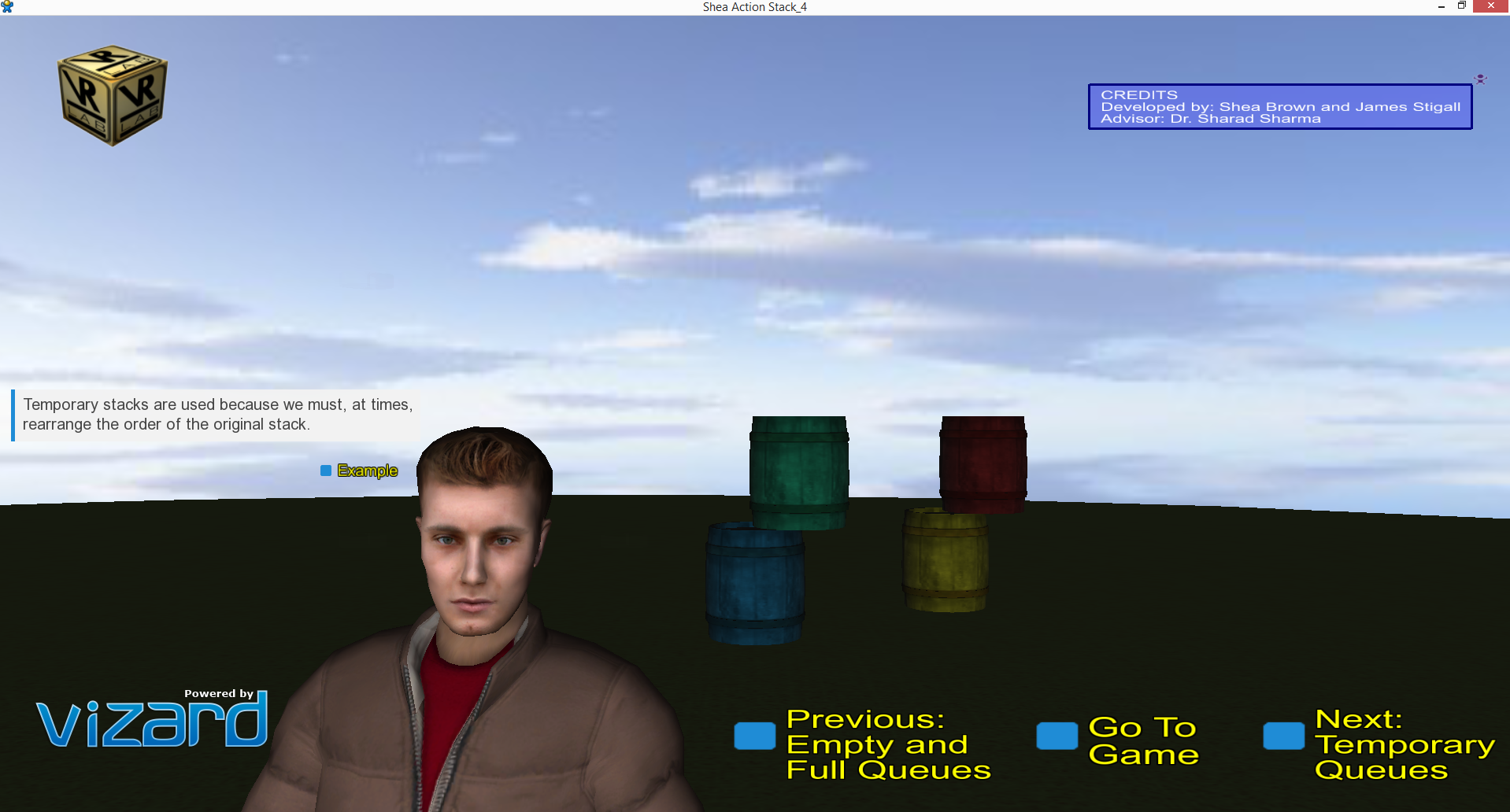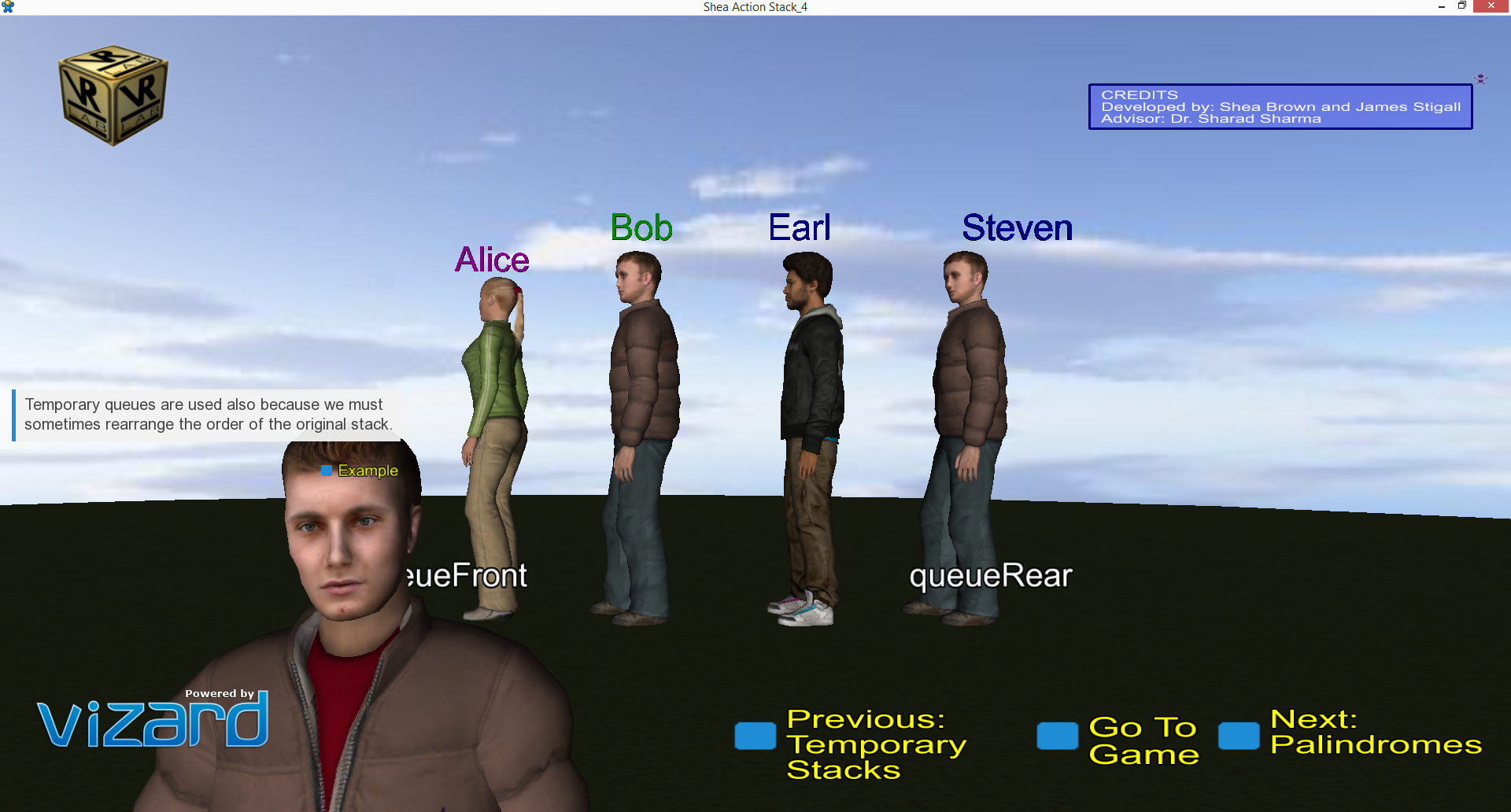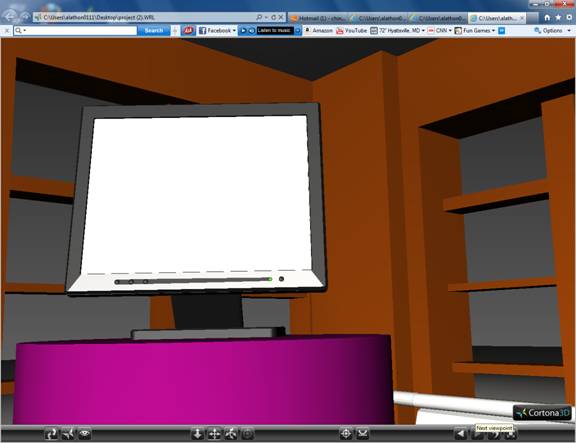 |
|
Game-Theme Based Instructional (GTI) or Virtual Reality Instructional (VRI) Modules
Current Students: James Stigall, Dr. Sarika Rajeev
Past Students: Gema Howell, Antoine Lathon,Stanley Woodroff, Emmanuel Ossuetta, Alonzo Ouzts, and Kim Ta
Status: Current
The goal of this project is to create course curriculum modules for computer science and mathematics students. Engineering and Mathematic courses are typically considered as difficult by college students and exhibit high failure rate. Due to the complication and abstract nature of computer hardware, it is a challenge for students to understand the principles and concepts related to computer organization. The aim is to create instructional course curriculum modules with more inquiry based problem-solving activities and hand-on experiences based on Gaming and Virtual Reality. The game theme instructional (GTI) modules endeavor to increase the students interest in learning programming concepts. However, the GTI modules should be usable and likable to include it in a class curriculum. We have incorporated a virtual instructor to help the users learn in the modules. We have evaluated the GTI modules using User Engagement Scale (UES), Theory of Reasoned Action (TRA), and Science Motivation Questionnaire (SMQII) to evaluate usability, likability, and motivation respectively. The result of evaluation shows that the modules are usable, likable, motivational, and engaging.
Instructional Modules 1: Linked List Instructional Module
Virtual reality instructional modules are widely recognized in academia because they engage students and motivate them to learn by hands-on experience. For this reason, we have developed Game Theme based Instructional (GTI) modules for the teaching linked list that can provide a better understanding of the concept than with a traditional instruction approach. We have developed and evaluated of the GTI gaming module, which adds more inquiry-based problem-solving activities and hands-on experiences based on gaming and virtual reality.
The GTI modules act as a supplement to an existing course and enables faculty to explore teaching with a game-theme metaphor. The linked list module was implemented using the Python programming language within the Vizard Virtual Reality Toolkit, a Python-based integrated development environment (IDE) used to develop virtual reality applications.
Instructional Modules 2: Circular and Doubly Linked List Instructional Module
We have used FDF (four-dimensional framework) with a minor extension for the design and development of GTI modules. The design of the GTI module is modeled on the constructive approach of learning. The purpose of this work is to overcome the intellectual crisis by providing a new way of thinking and learning. We have evaluated the GTI modules based on the five components of Science Motivation Questionnaire II (SMQII). The results of the evaluation of GTI modules show that the students feel self-determined and motivated towards their learning and career.
Instructional Modules 3: Binary Tree Instructional Module
We have used a proven four-dimensional framework to assess the perceived learning outcomes and effectiveness of GTI modules. The first dimension of the framework focuses on the context where the learning takes place. The second dimension of the framework, which we have used to identify the effectiveness of GTI module, focuses upon the attributes of learners. The third dimension of the framework focuses on pedagogic consideration. The fourth dimension of the framework emphasizes the mode of representation or tool for use.
Instructional Modules 4: OOPS (Object Oriented Programming) Instructional Module
This research focuses on the development of a game theme-based educational module that helps novice students understand object-oriented programming (OOP) concepts, specifically, encapsulation, polymorphism, and inheritance. This effort is motivated by the popularity and effectiveness of educational games. The module was implemented using Python within Vizard, a virtual reality development toolkit. Three-dimensional (3D) models featured in the module were created in 3ds Max 2014, a 3D modeling and animation software application. The results demonstrate that the module helped students learn OOP concepts and found the module user-friendly. During the Fall 2014 semester, the module was evaluated with undergraduate students in a programming course. The students experimented with the module and took a survey afterwards. Survey data demonstrates that the module makes a significant educational impact on students. [ Click Here for Poster] A user study found that about 75% of undergraduate students found the OOP module was easy to use and about 92% of them thought that it is effective at helping them learn OOP.
Instructional Modules 5: Stacks and Queue
The binary search module begins with a tutorial on binary search. The tutorial consists of a prompt explaining how to do binary search. Once the player completes the tutorial, he or she proceeds to the first round of the game.
 |
 |
| |
|
 |
 |
| |
|
 |
 |
| Binary Search Module |
Binary Search Module |
|
The user proceeds to the first part of the GTI module where they must uncover the green ball located underneath the middle cup. This represents the first part of the binary search algorithm, which states that the middle element within a given array must be searched first.
The GTI modules act as a supplement to an existing course and enables faculty to explore teaching with a game-theme metaphor. The linked list module was implemented using the Python programming language within the Vizard Virtual Reality Toolkit, a Python-based integrated development environment (IDE) used to develop virtual reality applications
Instructional Modules 6: Duck Game for Loop Statements
The goal is to design and develop Gaming Learning Module that teaches students how to use different condition statements (if/else, nested if/else, while loops, for-loops, & switches). The game shows the action and reaction to each condition, as well as a display of the code for the user to reference. It is created using 3ds Max and Worldviz Vizard. The duck court background was designed in 3ds max. After the design of the models, the finished product was exported to Vizard as a .ive file. The ducks and beach ball were an inbuilt 3d object from Vizard. Our hypothesis is that the use of instructional modules will lead to better student learning outcomes. We have conducted user studies for four semester to prove our hypothesis. We intend to build an interactive module to help students get a better grasp of what an array structure should be, and how its functions could be implemented. Our proposed educational module was developed using WorldViz Vizard toolkit.
We have evaluated the GTI modules in introductory programming courses during the semesters for computer science students. The student survey baseline results demonstrate positive student perceptions about the use of gaming instructional modules to advance student learning and understanding of the concepts. The results of the evaluation of GTI modules also demonstrate the effectiveness of instructional modules and the possibility to include them in the existing curriculum with minimum alterations to the existing established course material.
Students responded more positively to the Duck module than the Array. Eighty-six percent of students reported a good to excellent level of impact associated with the Duck instructional module compared to 79% for the Array module. In terms of extent of impact, most students reported a satisfactory level (i.e., “good) at 62% and 58% for the duck and Array instructional modules respectively. The interpretation of the Likert scale used on these surveys did not include the rating of “Very Good”, typically included in a Poor to Excellent continuum. This analysis therefore defines the rating scale in relationship to impact as follows: Excellent=Significant, [Very Good=Substantial], Good=Satisfactory, Fair=Moderate, Poor=Minimal.
Instructional Modules 7: Multidimensional Array Game
The goal of this project is to create Virtual Reality course educational modules with more inquiry based problem-solving activities and hand-on experiences. Programming courses are typically considered as difficult by college students and exhibit high failure rate. Through the use of this gaming instructional modules students will be able to learn the concepts of multidimensional arrays better and lead them to better success.
Our proposed instructional module uses a gaming metaphor in demonstrating the concepts of Multidimensional Arrays and objects. The proposed model is designed and developed using 3Ds Max and Vizard. We have created a 3D grid table as a structured array, with the help of standby avatar created as an instructor; users would be able to navigate their way through the game module. First the avatar introduces the concept of the game and then the user clicks the “Enter” button to begin the game. Also, on the left side on the screen, there is a list of object tools the user would use as data example for the array grid table.
We will be conducting user studies to evaluate if the module leads to a better learning outcome and if the students are able to grasp the concepts better using a gaming metaphor.
Instructional Modules 8: Mail-Box Array Game
The goal is to design and develop Gaming Learning Module that teaches students the concepts of arrays. It is created using Unity 3D and 3ds Max. |
| |
 |
 |
| |
 |
 |
| The above course module is to teach single and multi-dimensional arrays. |
| |
Instructional Modules 9: Computer Organization
The goal is to design and develop Gaming Learning Module that teaches students the different parts of a computer. For example power supply, memory storage by interacting with the computer in Virtual Reality. It is created using VRML and 3ds Max. |
| |
 |
 |
| |
Course module for showing power supply in the computer |
Course module for memory storage |
| |
|
|
Publications
- Rajeev,S., Sharma, S, "Evaluation of Game-Theme Based Instructional Modules for Data Structure Concepts ", International Journal of Computers and their Applications, IJCA, Vol. 27, No. 1, March 2020.
- Rajeev,S., Sharma, S, "Motivational Game-Theme Based Instructional Module for Teaching Binary Tree and Linked List, Proceedings of ISCA 28th International Conference on Software Engineering and Data Engineering (SEDE 2019) in San Diego, CA, USA , vol 64, pages 31-40, 2019.
- Rajeev,S., Sharma, S, "Evaluation of GTI modules based on usability and likeability", Proceedings of ISCA 27th International Conference on Software Engineering and Data Engineering (SEDE 2018), New Orleans, Louisiana, USA, pp. 69-74, October 8-10, 2018.
- Rajeev,S., Sharma, S, "Educational Game theme based Instructional module for teaching introductory programming", Proceedings of 44th Annual Conference of the IEEE Industrial Electronics Society (IECON 2018), Washington DC, USA, October 21-23, 2018.
- Stigall, J., Sharma, S, "Usability and Learning Effectiveness of Game-Themed Instructional (GTI) Module for Teaching Stacks and Queues", Proceedings of IEEE SoutheastCon 2018, Hilton Bay Front, St. Petersburg, FL, USA, pp. 1-6, April 19 - , 2018.
- Rajeev, S., Sharma, S, Sahu, A., "Game Theme Based Instructional Module to teach Binary Trees Data Structure", proceedings of ISCA 26th International Conference on Software Engineering and Data Engineering (SEDE-2017), San Diego,CA, USA, October 2-4, 2017.
- Stigall, J., Sharma, S.,"Virtual Reality Instructional Modules for Introductory Programming Courses ", proceedings of IEEE Integrated STEM Education Conference (ISEC),pages: 33- 41, DOI:978-1-5090-5379-7/17, Princeton, New Jersey, Saturday, March 11, 2017.
- Sharma, S., Ossuetta, E., "Virtual Reality Instructional Modules in Education Based on Gaming Metaphor", Explore the Future of Electronic Imaging at the 29th Annual Symposium, 2017 IS&T International Symposium on Electronic Imaging (EI 2017), The Engineering Reality of Virtual Reality 2017, Hyatt Regency San Francisco Airport, Burlingame, California, 29 January- 2 February 2017.
- Sharma, S., Stigall, J., Rajeev, S., "Game–Theme Based Instructional Module for Teaching Object Oriented Programming", proceedings of the IEEE International Conference on Computational Science and Computational Intelligence (CSCI), Las Vegas, USA, Page 252-257, DOI 10.1109/CSCI.2015.3, December 7-9, 2015.
- James Stigal and Dr. Sharad Sharma, "Game Theme-Based Educational Modules for Introductory Programming Courses", Oral Presentation, at the Emerging Researchers National (ERN) Conference in Science, Technology, Engineering and Mathematics (STEM), hosted by AAAS, EHR and NSF, Washington DC, February 19-21, 2015.
- Jeff Ruffin Jr and Dr. Sharad Sharma, "Game Theme Based Educational Module for Inheritance", Oral Presentation, at the Emerging Researchers National (ERN) Conference in Science, Technology, Engineering and Mathematics (STEM), hosted by AAAS, EHR and NSF, Washington DC, February 19-21, 2015.
- Jeff Ruffin Jr.and Dr. Sharad Sharma, "Educational Module: Programming Loops and Conditions Using Virtual Reality", Oral Presentation, at the Emerging Researchers National (ERN) Conference in Science, Technology, Engineering and Mathematics (STEM), hosted by AAAS, EHR and NSF, Washington DC, February 20-22, 2014.
- Antoine Lathon and Dr. Sharad Sharma, "Course Curriculum Module for Multidimensional Array and Linked List using Gaming Approach", Oral Presentation, at the Emerging Researchers National (ERN) Conference in Science, Technology, Engineering and Mathematics (STEM), hosted by AAAS, EHR and NSF, Washington DC, February 28th - March 2nd, 2013.
- Kim Ta and Dr. Sharad Sharma, "Gaming Approach to Learn Arrays In C++", Oral Presentation, at the Emerging Researchers National (ERN) Conference in Science, Technology, Engineering and Mathematics (STEM), hosted by AAAS, EHR and NSF, Washington DC, February 28th - March 2nd, 2013.
 VR LABORATORY (C) 2007-2020, ALL RIGHTS RESERVED
VR LABORATORY (C) 2007-2020, ALL RIGHTS RESERVED |
 |
|
